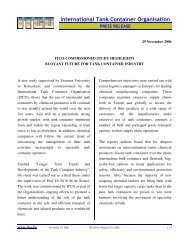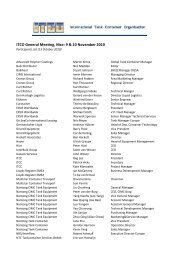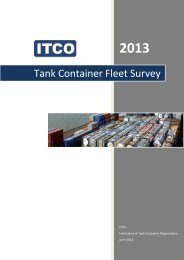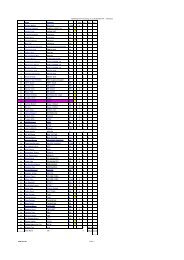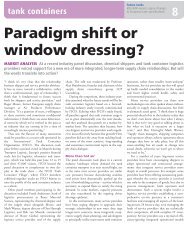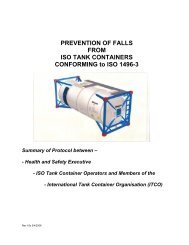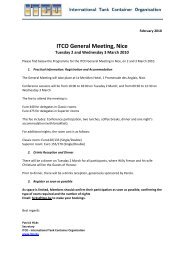Create successful ePaper yourself
Turn your PDF publications into a flip-book with our unique Google optimized e-Paper software.
ICHCA International <strong>Safe</strong>ty Panel Briefing Pamphlet No 30<br />
12.5.8 In summary the following are important when accepting a tank container and<br />
planning for their stowage on board a ship:<br />
Ensure the shipper / operator has not over or under filled the tank.<br />
See section 4.2.1.9 in the IMDG Code for specific guidance in this<br />
regard<br />
Ensure the shipper / operator has not filled the tank so that the<br />
combined mass <strong>of</strong> the cargo and the tare <strong>of</strong> the tank container<br />
exceeded the rated maximum gross mass <strong>of</strong> the container (see 12.2.3,<br />
Annex 1 Definitions and Annex 4 section A4.2.4).<br />
Plan the stow based on the tank’s gross mass and on the possible<br />
need to segregate its contents from other dangerous goods in the<br />
stow.<br />
Consider the tank container as a closed container for the purposes <strong>of</strong><br />
segregation but keep in mind that tank containers have relief devices<br />
that may release vapours during a voyage.<br />
Note: For substances with clear <strong>of</strong> living quarters in column 16 <strong>of</strong><br />
the Dangerous Good List, in deciding stowage, consideration<br />
shall be given to the possibility that leaking vapours may<br />
penetrate the accommodation, machinery space and other<br />
work areas. It should be kept in mind that vapours may pass<br />
down companionways and other openings into living spaces<br />
and work areas. Bulkheads, for example, between holds<br />
and engine rooms must be kept hermetically sealed.<br />
Consider the potential for a large spill and any attendant emergency<br />
response or clean-up activity that may be necessary.<br />
<strong>Tank</strong> containers loaded with a hazardous substance and stowed on<br />
deck but not intended for discharge at the terminal should not be left in<br />
the path <strong>of</strong> other containers or hatch covers being moved in the same<br />
bay. In such a case, the tanks should be either moved to another bay<br />
or, if that is not practical, placed at a safe location on the terminal as a<br />
re-handle(s).<br />
In planning stowage, consideration should be given to the plug-in<br />
arrangements necessary for certain cargoes in tank containers which<br />
need heating or cooling.<br />
13 Access to <strong>Tank</strong> Container Tops and Working at Height<br />
13.1 All tank containers where access to the interior can only be gained through a<br />
top opening or where the cargo is loaded through a hatch in the top <strong>of</strong> the<br />
container will be fitted with a means <strong>of</strong> climbing onto the container top.<br />
However these access means <strong>of</strong>ten will have restricted and in some cases<br />
incomplete rungs / steps.<br />
Page 40 ©ICHCA International Limited



